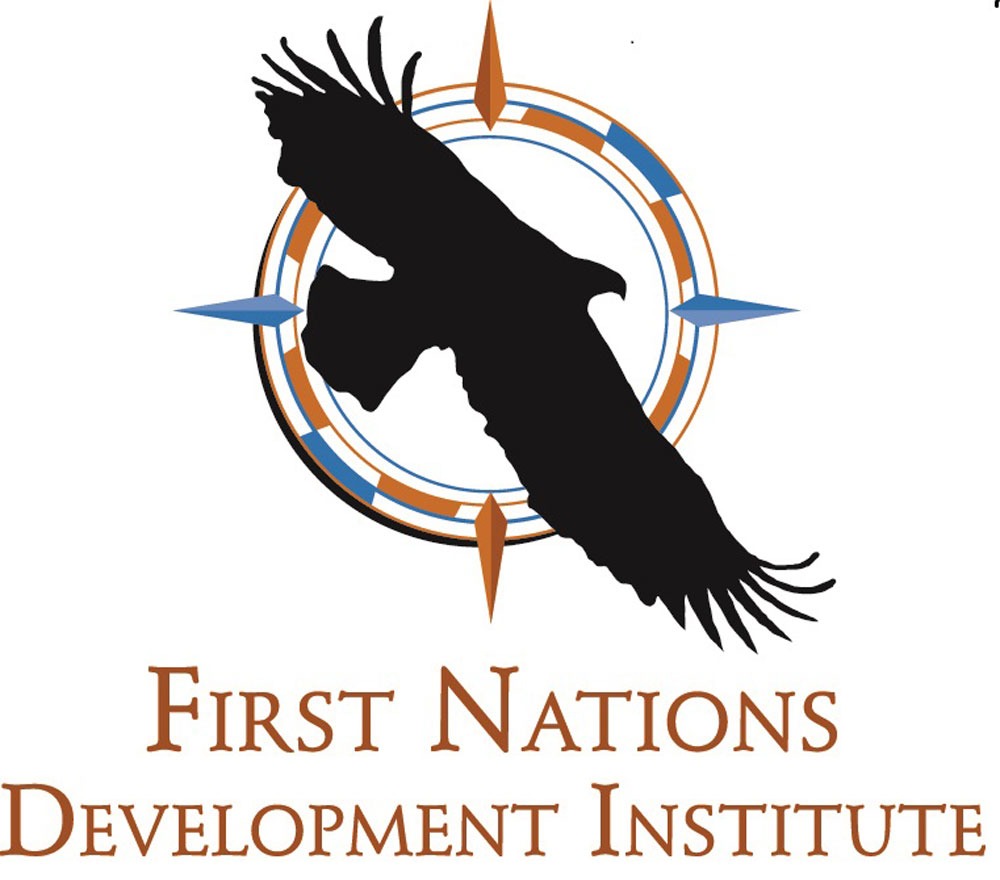
Click here to download this article as it appears in the magazine, with accompanying artwork.
This article was reprinted in the fall 2021 edition of the Nonprofit Quarterly, on Climate Justice.
This article from the fall 2020 edition of the Nonprofit Quarterly, is part of a series of works on the subject of environmental justice and Indigenous communities in the United States, curated by Raymond Foxworth of the First Nations Development Institute. You can read others here and here, and after that, join us this Thursday on October 15 for a webinar on the topic featuring three of the authors, hosted by Senior Editor Steve Dubb.

Indigenous people have been growing food, creating complex systems of agriculture, gathering, and practicing land stewardship long before the formation of any discipline, area of study, or social movement describing the relationships between environments and humans. Violent colonization and willful ignorance of these Indigenous land stewardship systems have led to the destructive replacement of the Indigenous relationships with our environment with parasitic, extractive systems, which now urgently need to be corrected.
Ironically, many of the movements (including current ones) that call for better understandings of and relationships with our environments have not included participation of Indigenous people. From its beginnings, the environmental movement broadly has excluded Indigenous peoples, ideologies, and practices worldwide; in many ways has justified the inhumane treatment of Indigenous peoples—removal, forced assimilation, continued aberrations of cultural practice in our own homelands; and has often been the strongest advocate for extinguishing Indigenous land rights.1 As hard as it may be to acknowledge and accept the truth of this reality, it is necessary in order to create better options and strategies that include Indigenous people and communities—for the balance of the environment and social health of society.
Regenerative agriculture holds great promise for the formation and direction of Indigenous inclusivity. Traditional agriculture and the environmental movement are rooted in the same Western anthropocentrism, in that they both start with timelines and definitions that often do not include Indigenous peoples, practices, and worldviews—and, further, are fiercely opposed to their inclusion. But regenerative agriculture, still in its infancy, has the power to be more than another oppressive movement. We have an opportunity now to create longevity that begins with Indigenous inclusion, which has much to teach through historical examples of where other fields of study and production have gone wrong. In this way, regenerative agriculture can actually generate change and socio-environmental balance.
The Violent Birth of the U.S. Environmental Movement
The environmental movement in the United States has roots in the Sierra Nevada mountains of California, the birthplace of the Sierra Club. In the mid- to late 1800s, California attracted men like Alexander von Humboldt, Josiah Dwight Whitney, and John Muir and Joseph Le Conte (cofounders of the Sierra Club)—“explorers”/scientists who studied, wrote about, and dedicated their lives to the protection of nature’s sublimity, in a time of growing national industrialization that required extractive industries to fuel its progress. They would become the foundation of the new discipline of environmental conservation and, generally, environmental science.2
When California became a state, in 1850, these men were in a frenzy to protect California’s natural landscapes, threatened largely by the discovery of gold, but even before that, by the extractive industries of California’s other rich resources—from oil to plants and trees to silver. They wrote incessantly about California’s natural beauty, consistently omitting California’s Indigenous people from their writings. This created the protocol for Indigenous omission thereafter—not only in the environmental movement conversation and land conservation policy development, but also in science; many of these early writers became founders of important scientific institutions, such as the California Academy of Sciences and, eventually, the University of California. Indeed, as Zachary Warma writes in “The Golden State’s Scientific White Supremacist,” Le Conte “spent the entirety of his life advocating and advancing the cause of white supremacy”3 —and Muir was a proponent of eugenics.4
As Muir, Clarence King, Whitney, Le Conte, and others were writing about the natural beauty of what is today called California, they never mentioned the ongoing campaign to violently eradicate Indigenous peoples from their land. Even before the California Gold Rush, the Spanish had created a mission system across California to indoctrinate and forcibly convert Indigenous people to Catholicism. They also introduced systems of indentured labor that dispossessed many Indigenous peoples of their land, which was then granted to Spanish settlers. This essentially created massive homelessness among Indigenous nations, whose people then returned to the missions.
This cycle of forced Indigenous labor lasted until around 1835, and the traditional lands became permanent land holdings in the American transfer from Mexico. After the signing of the Treaty of Guadalupe Hidalgo of 1848, which officially put an end to the Mexican-American War, American occupation of California began with the ceding of Spanish land holdings to the Americans.
Sign up for our free newsletters
Subscribe to NPQ's newsletters to have our top stories delivered directly to your inbox.
By signing up, you agree to our privacy policy and terms of use, and to receive messages from NPQ and our partners.
Between 1846 and 1873, while the U.S. government upheld grandiose ideas of freedom and liberty, California Indigenous people suffered unprecedented loss of life and land. This was often justified by Western science, including the popular eugenics movement and the newly formed environmental science movement, which regularly sought to create national parks in locales populated by Indigenous villages (sometimes directly on top of villages, as in Yosemite), gathering areas, and homelands. Some of the most prominent national parks—from Yosemite to the Redwood Forest National Park and the Sequoia National Park—were Indigenous homelands, cared for and stewarded over thousands of years. These places were—and are—spectacular because of Indigenous stewardship.
These coveted lands only became “available” when they were no longer occupied by the Indigenous people. Government-sponsored militias, who were paid as little as $1 per head, and U.S. military regiments sent under the guise of “surveying” would ultimately eradicate entire communities, sometimes at one time. While government-sponsored bounties on Indian body parts were alive and well, many Indigenous people continued to return to their homes, fight for their lands, and seek out allies to help them secure their lands. Eighteen different treaties were negotiated in California between numerous Indigenous nations and the U.S. government, but those same treaties were never ratified and then were bound to secrecy by a directive of the U.S. Senate to be “printed in confidence.”5
The very lands that mesmerized both the environmental scientists and extractive prospectors alike (and who were often one and the same) were the homelands of Indigenous people who were fighting to remain alive and on their lands during one of the darkest periods of Indigenous history—the very same period in which we see the birth of the environmental conservation movement.
This juxtaposition of death and birth remains a recurring theme in present-day environmentalism. Until recently, conservation largely meant an absence of human presence. Visit any national, state, and county park, and you will see these rules upon entry: “Stay on the trail. No picking plants. No disturbing the animals. Carry out what you bring in.” This is quite literally the opposite of Indigenous stewardship practices, which center on constant interaction with the landscape, an interdependence that can only be cultivated through continuous access. Many of the Indigenous stewardship practices have weakened because of inaccessible landscapes that have been “preserved” for future generations. Given this country’s historical and current policies and practices, one has to question whether Indigenous people are included in this idea of future generations. Recently, Muir’s affiliation with racist ideologies such as the eugenics movement made headlines when the Sierra Club officially cut ties with him.6 But he was but one player in a larger systematic institutional erasure of Indigenous people from both the study and the land. The pillars of those institutions still stand today, even without men like John Muir.
Regenerative Agriculture
Regenerative agriculture, a current area of interest for many in the agricultural community, holds promise. But as many within and around the field watch regenerative agriculture unfold and grow, it is important to remember the beginnings of previous movements. And the unanswered question is: How can Indigenous people be justly included at the inception?
The idea of regenerative agriculture has been circulating since at least the early 1980s, but it wasn’t widely adopted until around 2014. It started out in much the same way as the environmental movement and traditional agriculture, in that it was a response to destructive systems of land stewardship. In the 1980s, Rodale Institute’s formulation of “regenerative organic” agriculture was a holistic approach to farming that encouraged continuous improvement of environmental, social, and economic measures.7 This was later refined in 2018 by Ethan Roland Soloviev and Gregory Landua, who identified four levels of regenerative agriculture, organized as successive stages in a progressive framework of principles and practices: (1) a “functional” level, focused on best practices that regenerate soil health and sequester carbon; (2) an “integrative” level, focused on more holistically designing farms to improve the health and vitality of the wider ecosystems, not just soil; (3) a “systemic” level, which views the farm within wider ecosystems of enterprises building multiple forms of capital; and (4) an “evolutionary” level, involving “pattern understanding of the place and context” over generations within which agriculture takes place.8 More important, regenerative agriculture seeks to replace the harmful practices of past production systems.
If regenerative agriculture is a means of addressing harmful production systems of the past, the essential question is, what harms should we be addressing? While many regenerative agriculturalists focus on soil and carbon depletion, these are outputs—the end of the story. The beginning and plot of the story are the “how and why” of the adoption of agriculture and its current state. This beginning and plot, too, must be understood and addressed. The study of American agriculture and its promotion was largely a creation of Euro-American forefathers, who used agriculture as a distinguishing trait to differentiate the “yeoman farmer worker/settler” from “the wild, untamed Indian”—as if Indigenous people did not practice agriculture. This historical narrative allowed for the removal of entire nations of Indigenous people to reservations to make way for “progress” that began with the plow—but in reality, the underlying message was that progress began with removal of the Indian. Similarly, the environmental conservation movement itself began when Indigenous people were violently removed from their homelands. The recurring theme in both approaches has been to remove the Indians; regenerative agriculture must not follow suit.
We should answer the question “What harms are we addressing?” by starting at the beginning of the story. Environmental conservation and agriculture are examples of colonial erasure and extraction because they erase Indigenous history, negate past and present contributions, and make it that much harder to participate in future directives in either field. This parasitic framework is damaging to all of society—however, many producers, organizations, and communities have developed their own responses to it: Sustainable agriculture, organic agriculture, permaculture, agroecology—to name a few major movements and communities—are proposed solutions to an anthropocentric agricultural system that dominates America. (Arguably, we have entered a new era of technological agriculture that minimizes humans altogether.) Many of these responses find ways to work around the colonial framework or minimize the producer to focus on the natural processes of the environment; but few, if any, challenge the historical injustice and violent removal of Indigenous peoples from their lands and corresponding stewardship of those lands. Regenerative agriculture can and should challenge those harms. It can restore the balance of relationship between people and land, environment and production, history and future.
…
If there is a lesson to be learned from the not-too-distant timelines of the environmental conservation movement and the study of agriculture, it is that the stories are largely controlled by the founders, who chose to mythologize or even omit altogether Indigenous peoples. Regenerative agriculture is at its very early stages and could incorporate Indigenous founders, practitioners, and communities into its understanding, ethos, and practices. In its attempts to regenerate diminished, exhausted, and exploited lands as a result of anthropocentric agricultural systems, regenerative agriculture shouldn’t just focus on the soil itself. The story of our soils, our lands, and the Indigenous people who carry those stories—those harms and the history—have always been the beginning of the story, whether told or not. In those stories are not just the tale of food production and resource management but also the tale of exploitative institutions that damage our entire society. But this story also contains narratives of strength, love, painstaking survival, fortitude, endurance, and adaptability that even the most powerful of institutions could not erase, despite their attempts. After all, when it comes to the revitalization of a damaged system, Indigenous people have quite literally lived, and continue to live, through all the phases, from creation to destruction to regeneration.
Notes
- See, for example, Marcus Colchester, “Conservation Policy and Indigenous Peoples,” Cultural Survival Quarterly Magazine (March 2004).
- Many of these men were geologists and engineers interested in exploiting natural resources, and a case might be made that they mostly wanted to exploit, but set aside a few remarkable “preserves.” See, for instance, Zachary Warma, “The Golden State’s Scientific White Supremacist: The Legacy of Professor Joseph Le Conte and Toppling California’s Lost Cause Monuments,” Boom California, November 5, 2018; and Josiah Dwight Whitney, The Yosemite Book: A Description of the Yosemite Valley and the Adjacent Region of the Sierra Nevada, and of the Big Trees of California, illustrated by maps and photographs (New York: Julius Bien, 1868).
- Warma, “The Golden State’s Scientific White Supremacist.”
- Jedediah Purdy, “Environmentalism’s Racist History,” New Yorker, August 13, 2015.
- Larisa K. Miller, “The Secret Treaties with California’s Indians,” Prologue (Fall/Winter 2013).
- Michael Brune, “Pulling Down Our Monuments,” Sierra Club, July 22, 2020.
- “Regenerative Organic Agriculture,” Rodale Institute, accessed August 18, 2020.
- Ethan Roland Soloviev and Gregory Landua, Levels of Regenerative Agriculture, Terra Genesis International, September 2016; and Ethan Soloviev, “Regenerative Agriculture Industry Map,” Re-Source: Ethan Soloviev on Regenerative Agriculture, Business, and Life.











